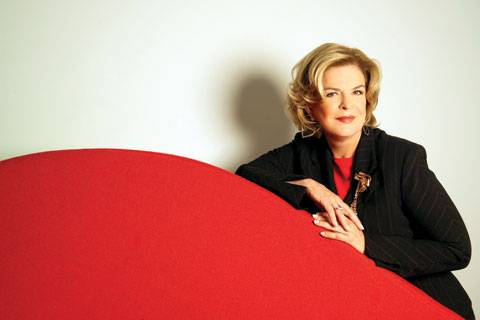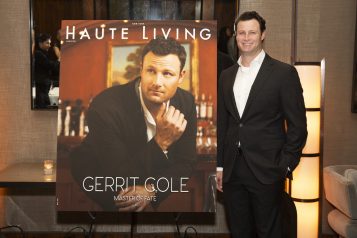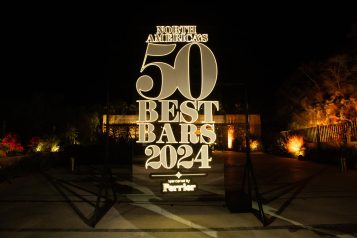Arthur and William Lie Zeckendorf represent the third generation of a distinguished real estate family that helped shape New York’s skyline. With sales topping $1 billion at 15 Central Park West, these two brothers are leaving their own indelible mark upon the city.
By Michael Calderone
Photography by Scott Rudd
On a bright September morning, Arthur and William Lie Zeckendorf were seated in the 44th-floor sales office for 15 Central Park West, their quick-selling luxury condominium under construction nearby.
But even from this lofty perch, with an unobstructed view of New York’s iconic architecture-including contributions by their grandfather and father-the younger Zeckendorfs are not getting too caught up in the past. As William says, “Manhattan is not a town that lets you coast on a legacy.”
In 1992, after about a decade working for their father, the brothers formed Zeckendorf Development LLC. Serving as co-chairmen, Arthur and William have developed several high-end buildings, including the ritzy 515 Park Avenue. However, it’s 15 Central Park West, the Robert A.M. Stern-designed apartment building, that is setting them apart in New York’s highly competitive real estate market.
Ever since the mid-1990s, with their budding partnership still in its infancy, the brothers have had their eye on the full-block parcel between 61st and 62nd streets-a true rarity on this legendary avenue. Along Central Park West stand some of Manhattan’s most storied apartment buildings: the Dakota, the San Remo, the Beresford. Surprisingly, a segment of the choice property had been vacant for almost two decades while the remainder was the site of the former Mayflower Hotel.
“It was the worst-kept secret in town that everyone was looking at it,” William said. “You have a roster of developers who looked at it over the past 12 or 13 years.”
Obviously, real estate is a cut-throat industry, so the Zeckendorf brothers had to jump ahead of the pack. “We really spent the time to study and understand the property,” William said. In the end, Arthur and William convinced the sellers that they would make best use of the exceptional space, which overlooks Central Park and is near Trump International Hotel and Tower and the Time Warner Center.
In recent years, superstar architects have been all the rage with high-end condo buyers-from Herzog and de Meuron’s 40 Bond Street to the three Richard Meier-designed towers in the West Village. However, an ultra-modern, glass and steel structure just wouldn’t work at this location. “From day one,” William remembered, “Bob had the most compelling vision for the property.”
Of course, Bob is short for renowned architect Robert A.M. Stern, the dean of the Yale University School of Architecture. In recognition of Manhattan’s rich architectural tradition, the building’s facade will be clad in Indiana limestone-the same precious rock used for the Empire State Building, Metropolitan Museum of Art and 740 Park Avenue. And speaking of the ever-exclusive 740 Park, that building’s architect, Rosario Candela, was sighted by Stern as an inspiration for the classic apartment layouts. A few of the building’s 202 luxury units measure up to 7,000 square feet.
Although the exterior may owe a debt to pre-war aesthetics, there’s definitely no shortage of modern luxuries to be found within the building’s two wings: The Tower, 43 stories; and The House, 20 stories. Indeed, there’s a Theo Kalomirakas-designed private screening room, temperature-controlled wine cellars and state-of-the-art kitchen appliances (with a private chef available). There’s also a 13,500-square-foot fitness center, which boasts a competition-size swimming pool, a sauna, a couple steam rooms, a weight-training room and a 15-foot vaulted ceiling with skylight.
In September 2005, the sales office opened at a moment when newspaper headlines were forecasting a bursting real estate bubble. A year later, 15 Central Park West is roughly 75-percent sold, according to the Zeckendorfs. With units ranging in price from $2 million to $45 million, that adds up to over $1.2 billion in sales-a North American record for condominiums. And there’s been no shortage of bold-face buyers, either. Reportedly, future residents include Denzel Washington, Sting and hedge-fund manager Daniel Loeb.
“Our thought process was to design the premier building in Manhattan,” Arthur said. “It was a philosophy that we agreed to from the beginning-to stand out as the best new building.”
While discussing 15 Central Park West, Arthur acknowledged a couple of helicopters passing over the city. “It’s probably for the United Nations,” he said. Indeed, the General Assembly was meeting at U.N. headquarters on Manhattan’s East Side. Ironically, had it not been for Arthur’s grandfather, those world leaders would probably instead be congregating in Philadelphia.
Following World War II, several major cities competed to host the future U.N. headquarters, including San Francisco, Philadelphia and New York. Not unlike contemporary times, it was difficult to find a huge block of developable land on the island. But William Zeckendorf was in possession of a large chunk of Manhattan: The savvy developer had assembled 17 acres along the East River, with designs to create a massive residential and commercial complex.
In December 1946, with the city’s hopes of securing the location growing increasingly dim, William Zeckendorf offered his land. “There is no question the idea was his,” William said. For $8.5 million, far below market value, Zeckendorf unloaded the sizeable plot to John D. Rockefeller Jr., who subsequently bequeathed it to the U.N. While he didn’t instantly reap a great financial reward with the deal, their grandfather helped raise the profile of the Zeckendorf family among the city and world elite.
Throughout his career, William Zeckendorf either owned or developed numerous buildings, including the Chrysler Building, St. Regis Hotel, Drake Hotel and Chase Manhattan Plaza. His son, William Jr., followed in his footsteps, becoming a prominent developer in his own right. That’s where Arthur and William enter the picture.
“When you’re young and your father is building, it is a very exciting, engaging business to become involved in,” said Arthur, who recalled witnessing the construction of Zeckendorf Towers at Union Square. The brothers never seriously entertained the idea of choosing a career other than real estate: “When you’re in your 20s, it’s certainly a fascinating job to have,” Arthur said. When William Zeckendorf retired in 1992, the brothers, then in their early 30s, were prepared to break out on their own.
Each day, Arthur and William speak to each other about half a dozen times, tackling the myriad issues required to keep a real estate empire running. As for their specific responsibilities, William said that “there is no way to put an organizational chart together where one does X and one does Y.” Their roles are overlapping.
Both men admit that developers are “by nature optimistic” but over-extending themselves might lead to sub-par work. For the past few years and through 2008-a year after occupancy begins at 15 Central Park West-they will focus primarily on that project. “We’re not trying to do 25 things at once,” William said. In the morning, the Zeckendorf brothers hold an internal meeting with the project’s supervisors, review construction schedules and stop at the site-conveniently located near their homes. “If we were developing in Chicago,” Arthur said, “you’d have to fly there and start to lose contact.”
That attention to detail is something they learned during the development of another luxury apartment building, the 43-story condominium at 515 Park Avenue. From 1995 to 2000 the brothers devoted a considerable amount of their lives to that project, and it paid off. Several prominent buyers eventually lined up, including New Jersey’s Gov. Jon Corzine, music producer Antonio “L.A.” Reid and French billionaire François Pinault.
Also, in 1995, they purchased Terra Holdings, the parent company of nine different real estate brokerages, including Halstead Property and the venerable Brown Harris Stevens. A major advantage to owning Terra Holdings, in conjunction with their ongoing developments, is that it provides real-time market information-such as data concerning contracts being signed throughout the city.
The two brothers get along very well, which is fortunate because these days, Arthur and William might cross paths at one of three offices: Zeckendorf Development on Broadway, Terra Holdings on Lexington and the 15 Central Park West sales office in the Carnegie Hall Tower. Also, they may become neighbors in their new condominium-Arthur’s definitely moving in; William is still unsure. And, of course, there are family matters, too. On the evening of this interview, the brothers were planning to take their mother out for her birthday dinner.
With the last name Zeckendorf, it may seem tough to forge an identity of one’s own. But Arthur and William have brought their family name into the 21st century, adding innovations of their own, such on-site marketing. While the brothers are “totally focused on Manhattan,” according to Arthur, “they will, wisely, not reveal the details. Regardless of where they build next, it can be assumed that the Zeckendorf brothers will be very happy to replicate the triumph of 15 Central Park West.
“Our entire desire-like good artists-is to create a fantastic product,” Arthur said. “Instead of doing four or five projects, it’s doing one sensational project. It’s about creating an important building architecturally and making it a success financially.”





















